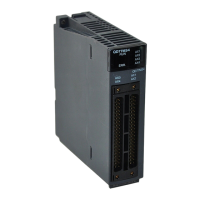3 - 60 3 - 60
MELSEC-Q
3 SPECIFICATIONS
3.5.2 Error code (buffer memory address 0: Un\G0)
Error code is stored when an error of Q62HLC occurs.
When checking the error code on the system monitor of GX Developer, monitor with
hexadecimal. The numeric value at the last digit shows the error code.
b15
b4 b2 b0
Error code
Error occurrence addres
(1) When data is written from the programmable controller CPU, the Q62HLC
checks:
• Whether write data range is proper or not
(2) The following processings are performed at error occurrence.
• Error code is stored (refer to Section 8.1).
• The buffer memory address is stored in the error occurrence factor, when a
write data error occurs.
The factor code is stored in the error occurrence factor for AT error
completion or hardware error.
• Error flag (Xn2) is ON.
(3) If more than one error has occurred, the error code and error occurrence
address of the error having the highest priority are stored. (Refer to Section 8.1.)
(4) Refer to Section 8.1 for error resetting.

